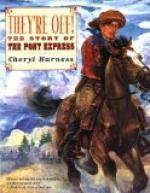During this same morning, a Mexican pony rider came in, mortally wounded, having been shot by the savages from ambush while passing through a dense thicket in the vicinity known as Quaking Asp Bottom. Although given tender care, the poor fellow died within a few hours after his arrival. The mail was waiting and it must go. Kelley, who was the lightest man in in the place — he weighed but one hundred pounds — was now ordered by the boss to take the dead man’s place, and go on with the dispatches. This he did, finishing the run without further incident. On his return trip he had to pass once more through the aspen thicket where his predecessor had received his death wound. This was one of the most dangerous points on the entire trail, for the road zigzagged through a jungle, following a passage-way that was only large enough to admit a horse and rider; for two miles a man could not see more than thirty or forty feet ahead. Kelley was expecting trouble, and went through like a whirlwind, at the same time holding a repeating rifle in readiness should trouble occur. On having cleared the thicket, he drew rein on the top of a hill, and, looking back over his course, saw the bushes moving in a suspicious manner. Knowing there was no live stock in that locality and that wild game rarely abounded there, he sent several shots in the direction of the moving underbrush. The motion soon ceased, and he galloped onward, unharmed.
A few days later, two United States soldiers, while traveling to join their command, were ambushed and murdered in the same thicket.
This was about the time when Major Ormsby’s command was massacred by the Utes in the disaster at Pyramid Lake[27], and the Indians everywhere in Nevada were unusually aggressive and dangerous. There were seldom more than three or four men in the little station and it is remarkable that Kelley and his companions were not all killed.
One of Kelley’s worst rides, in addition to the episode just related, was the stretch between Cold Springs and Sand Springs for thirty-seven miles without a drop of water along the way.
Once, while dashing past a wagon train of immigrants, a whole fusillade of bullets was fired at Kelley who narrowly escaped with his life. Of course he could not stop the mail to see why he had been shot at, but on his return trip he met the same crowd, and in unprintable language told them what he thought of their lawless and irresponsible conduct. The only satisfaction he could get from them in reply was the repeated assertion, “We thought you was an Indian!"[28] Nor was Kelley the only pony rider who took narrow chances from the guns of excited immigrants. Traveling rapidly and unencumbered, the rider, sunburned and blackened by exposure, must have borne on first glance no little resemblance to an Indian; and especially would the mistake be natural to excited wagon-men who were always in fear of dashing attacks from mounted Indians — attacks in which a single rider would often be deployed to ride past the white men at utmost speed in order to draw their fire. Then when their guns were empty a hidden band of savages would make a furious onslaught. It was the established rule of the West in those days, in case of suspected danger, to shoot first, and make explanations afterward; to do to the other fellow as he would do to you, and do it first!




